Polar Bear, Polar Bear, What Do You Hear? Story-related Science Pack for Preschoolers
Affiliate Disclosure: “This post contains affiliate links, which means I receive a small commission, at no extra cost to you, if you make a purchase using those links.”
Preschoolers are naturally curious about their world; therefore, they need to engage in science activities early in life. The secret is to do hands-on experiments with them, answer their questions, and let them explore and experiment.
Polar Bear, Polar Bear, What Do You Hear? written by Bill Martin Jr. and Eric Carle, uses the important pre-reading concepts of rhyme, rhythm, and repetition to help children identify wild animals and the noises they make.
The animals and people featured in the book in the order of appearance are a polar bear, a lion, a hippopotamus, a flamingo, a zebra, a boa constrictor, an elephant, a leopard, a peacock, a walrus, a zoo keeper, and children.
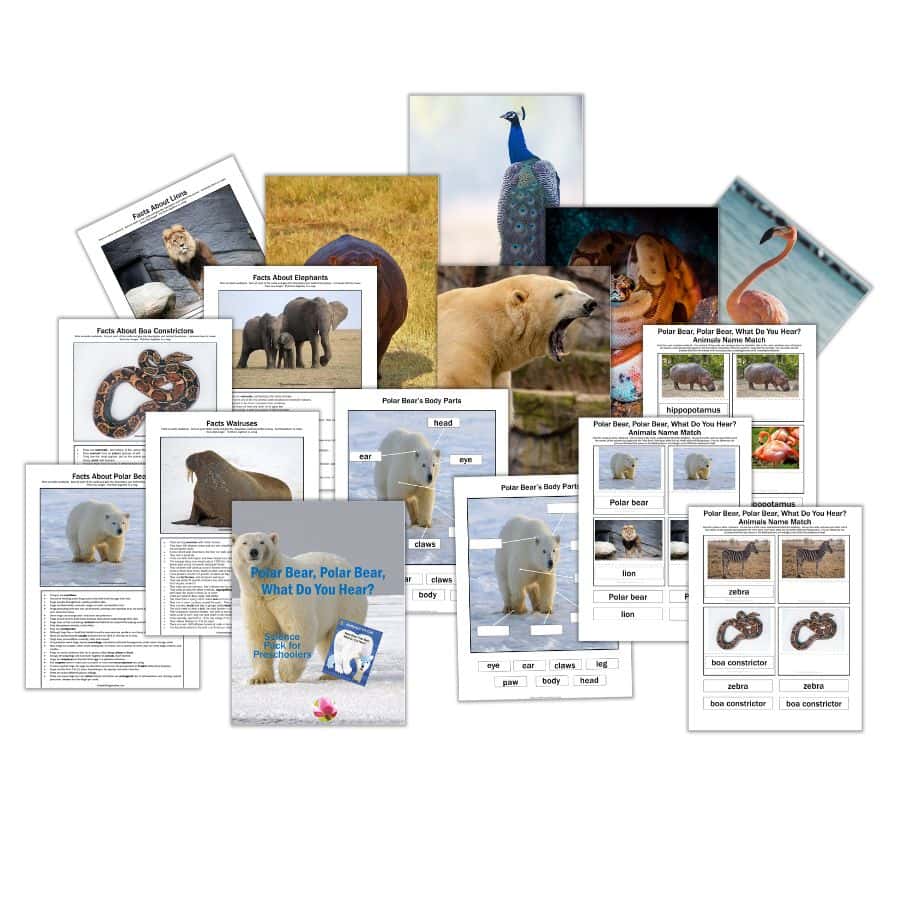
I have created a FREE 28-page Polar Bear, Polar Bear, What Do You Hear? science pack with four educational printable sets related to the story, which you can download at the end of this post.
Introducing Science to Preschoolers
You can introduce Science to your preschoolers by saying that it is the study of the world around us, and the part of Science that studies animals is called Zoology.
Since children are always trying to make sense of what they perceive with their senses, ask tons of questions to find the “why” about things, and are always investigating to find out how things work, we must take advantage of their natural curiosity and help them develop their scientific thinking.
Taking your time to introduce science to young children in a fun and interactive way, gives them many benefits. Some of them are:
- Use their interest in exploring and experimenting to establish a positive connection to science and encourage them to love it and stay interested for many years, if not throughout their life.
- Stimulate their scientific thinking, helping them make sense of the world around them, and understand why things happen and how they work.
- Extend their vocabulary promoting language development using scientific words, their communication, teamwork and cooperation, reasoning, and problem-solving skills. You can use science to teach every domain because it can easily tie up to literacy, math, and art.
Therefore, always encourage your children to ask questions, observe different types of natural phenomena, experiment, and explore, but, most importantly, give them plenty of opportunities to do just that by offering fun, interactive, and hands-on experiences.
Polar Bear, Polar Bear, What Do You Hear? Science Pack
There are many science activities you can do using this storybook as a base. I’m sure you can come up with many, but I wanted to give you some of the activities I like to use.
Explain Important Facts About the Animals in the Story
Create a KWL chart with their answers (K = what they know; W = what they want to know and L = what they learn).
Show them toy animals or real pictures of the animals in the story. Ask them if they know what animal is each of them, and what they know about these animals. Write down everything they know about these animals in the K column.
Then ask them what they would like to know about the same animals, and write their answers under the W column.
At the end of the theme, when you review what they learned, write down the information in the L column). Keep it up to allow them to review the KWL chart, discuss the information, and ask questions about it.
Below are some important facts about each of those animals.
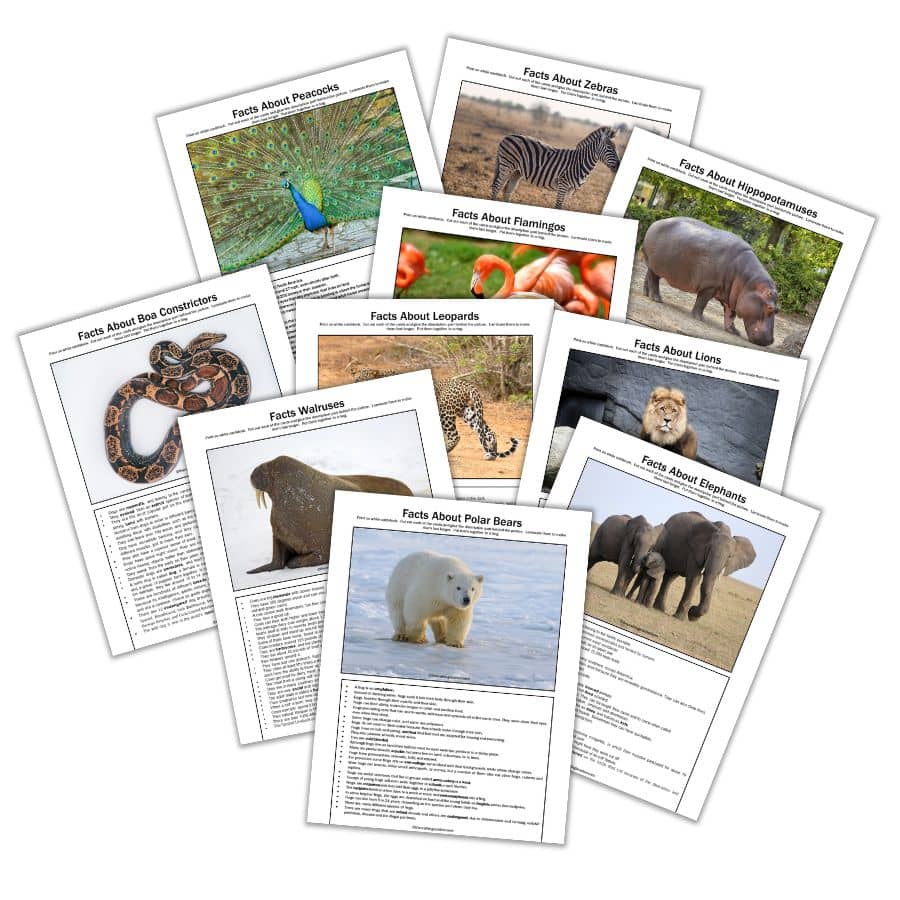
Facts About Polar Bears
- Polar bears are intelligent marine mammals and the largest carnivores on land.
- Their skin is black, and their fur is transparent with a hollow core that reflects light.
- They have two layers of fur to help them stay warm, and have a greasy coat, so they dry faster after swimming.
- They have 12-inch paws and large claws. They use their webbed feet as paddles that help them be excellent swimmers.
- They have amazing eyesight, hearing, and sense of smell to find prey.
- They eat seals, caribou, grass, walrus, beached whales, seaweed, vegetation, geese, and bird eggs, but they can survive for seven to ten days without food.
- Polar bears have 42 sharp teeth. They also have a gap between their front and back teeth to help them grab seals out of the water to the ice.
- Polar bears gallop to move around.
- Their nostrils close when they are swimming, and their short tails and ears prevent them from losing heat.
- Adult male polar bears usually weigh about 1,200 pounds or more, are over 8 feet long when measured from their nose to their tail, and can stand 10 feet tall.
- Polar bears also communicate through sight, touch, smell, chuffing sounds, roars, hisses, and growls when they are angry.
- When polar bears are looking for a mate they get stinky feet.
- They clean their bodies by rolling around in the snow.
- Polar bears spend part of the year on land but they don’t have territory, because the ice moves all the time.
- They like to be alone, but sometimes they can be found in a group called a pack or a sleuth.
- An adult male polar bear is called a boar, a female is called a sow, and a baby is called a cub.
- Polar bears don’t hibernate.
- Mother bears build snow dens to birth two cubs which are very small, about the size of a stick of butter. The cubs will stay with their mother for about two years.
- Polar bears can live for about 25 to 30 years in the wild.
- Polar bears are considered vulnerable because they are losing their habitat due to climate change, and scientists think they might become extinct in the coming years.
Facts About Lions
- Lions are the second largest big cat species in the world (behind tigers).
- They are extremely fast runners, but they can’t run this fast for very long.
- Lions tend to dominate cheetahs and leopards, which is another reason they are considered kings and queens of the jungle.
- Male lions are easy to recognize thanks to their distinctive manes.
- Male lion roars can be heard up to 5 miles away.
- Lions are carnivores, which means they eat meat and hunt other animals for food.
- Lionesses are better hunters than males and do most of the hunting.
- Males patrol their territory and protect their young.
- Baby Lions are called cubs, lionet, or whelp.
- Lions live up to 16 years in the wild.
- They are social creatures that live in family groups where they hunt together.
- Lions are the only known type of cat that lives in groups, which are called pride.
- Lions are mammals, and a lioness can have one to four babies at a time.
- When lions breed with tigers the resulting hybrids are known as ligers and tigons. There are also lion and leopard hybrids known as leopons and lion and jaguar hybrids known as jaglions.
- The main two types of lions are the African and the Asian.
- Lions are an endangered species.
Facts About Hippopotamus
- Hippopotamuses are the third largest mammal on land, behind the elephants and the rhinoceros.
- Their name means “river horse”.
- They are closely related to whales.
- They have short legs but can run up to 19 miles per hour.
- Their mouth is huge, with very large teeth.
- Their bodies are shaped like barrels.
- Their skin is delicate and can get overheated very easily.
- They spend most of their time in the water or mud and go to land in the evening when the sun goes down.
- They are herbivores and only eat grass and plants.
- They are so aggressive, that they are considered the most dangerous African animal.
- They can be found in African savannahs, forests, rivers, lakes, and swamps.
- A male hippopotamus is called a bull, a female is called a cow, and a baby is a calf.
- They live in large groups called a herd.
- They are now considered vulnerable because they are poached for their meat and teeth.
Facts About Flamingos
- Flamingos are birds.
- The skin on their legs is tough, which helps them survive in very salty waters, and can bend, just like in humans.
- They can stand on one foot for a long time.
- They sleep on one foot with their heads resting on their backs.
- They have webbed feet to help them swim.
- They molt their flying feathers to grow new ones.
- Flamingos spend most of the day feeding and distributing oil to their feathers from a gland at the base of their tail for waterproofing. This process is called preening.
- Their feathers are white but turn pink because they eat algae, seeds, shrimp, larvae, and plants that produce yellow, orange, or red pigments, that color their feathers. This process takes several years.
- To eat, flamingos place their heads upside down in the water, their bills pointing down, and then sweep their heads side-to-side, using their tongues to pump water in and out of their bills, trapping their prey inside.
- They don’t have teeth. Instead, they have a comb-like structure called lamellae.
- Some flamingos migrate to warmer for the winter.
- They live in groups, sometimes of thousands of individuals, in shallow saltwater or in areas where saltwater and freshwater mix in the Bahamas, Mexico, Cuba, the Southern Caribbean, Africa, Asia, Europe, and the Galápagos Islands.
- A group of flamingos is called a flamboyance.
- There are six species of flamingos.
- Flamingos couples stay together forever and participate in the nesting, incubation, and care of their baby, called a flaminglet.
- They are oviparous, and females lay one large egg in a nest made of mud and shaped like a volcano.
- Flamingo flaminglets are white-gray and have straight bills when they hatch. Their bills take the classical hook shape when they mature.
- Both parents produce a special substance on their throats full of proteins and fats, that they regurgitate to feed their chick until it’s old enough to eat prey.
- Flamingos normally live up to 30 years, but some have lived for 50 years.
Facts About Zebras
- Zebras are mammals.
- They have excellent eyesight and hearing.
- Their ears show their mood.
- They can see items to the side of them in addition to what is in front of them.
- Every zebra has a unique pattern of white and black stripes meant for camouflage, so they cannot be seen in the grass by predators.
- They can run as fast as 40 miles per hour, and in a zig-zag pattern when being chased.
- Their skin is black under the white coat.
- They are one of the single-hoofed animals.
- They stay clean by rolling around in the dust and rubbing their body and head against trees and rocks.
- Depending on the species, they can grow from 3.5 to 5 feet tall and weigh close to 1000 pounds.
- Common plain zebras have tails around 18 inches in length.
- Zebras live in different areas of Africa, depending on the type.
- They communicate with facial expressions, barking, braying, snorting, huffing, and the position of their ears.
- They are herbivores and spend most of their time eating grass.
- Zebras are social animals and live in groups called herds.
- There is typically a lead male of the herd, called a stallion, females are called mares, and babies are called foals.
- They give birth to one foal, every 2-3 years, and can breed with donkeys, horses, and ponies.
- A zebra does sleep standing up in a large group to feel protected.
- In the wild, they can live up to 20 years, and around 40 years in a zoo.
- There are three different zebra species: Plain Zebras, Mountain Zebras, and Grevy’s Zebra.
- The Plains Zebra is not endangered, the Mountain Zebra is considered vulnerable, and the Grevy’s zebra is endangered.
Facts About Boa Constrictors
- Boa constrictors are snakes.
- They have thick, muscular bodies that can easily crush their prey.
- They have two pits on either side of their head, which help them detect heat radiated by their prey that is up to three feet away.
- They have a triangle-shaped marking between their snout and eyes.
- Depending on where they live, their skin is usually cream or grey and has a yellow, green, or red pattern with diamonds, circles, or oval shapes outlined in black, to camouflage. These patterns are called saddle-like markings.
- They shed their skin as they grow.
- They can grow up to 13 feet long, and weigh more than 100 pounds.
- They are cold-blooded reptiles and must warm up in sunlight for a few hours.
- They live in dry tropical forests and deserts, and agricultural areas with a water source nearby of South and Central American countries, such as Mexico, Argentina, and Peru.
- They don’t have fangs like venomous snakes, but they have small teeth.
- They like to ambush their prey and when they catch it, they hold it with their teeth and wrap their bodies around it to stop the flow of blood, killing it. This is called constriction. Then, they unhinge their jaws and swallow it whole.
- They are carnivores and, depending on their size, they eat anything they can fit into their mouth, from birds. rodents, birds, lizards, mongooses, bats, and aquatic animals, up to pigs, alligators, and farm animals.
- After the meal, it takes from four to six days to digest their prey.
- Boa constrictors are solitary, nocturnal (active at night), and crepuscular (meaning they come out during the twilight hours).
- They are ovoviviparous, which means that eggs develop inside the female’s body, which gives birth to up to 60 live babies at once.
- They can live 20 to 30 years in the wild and about 40 years in captivity.
- In some places, they are losing their habitats, are hunted to be consumed or sold as pets, and killed for their skin in such quantities, that are an endangered species.
Facts About Elephants
- Elephants are the largest land mammals in the world.
- Elephants’ tusks are made of ivory, and never stop growing.
- Asian female elephants don’t have tusks.
- Elephants’ large thin ears help regulate their temperature.
- African elephants have ears shaped like the continent of Africa.
- Asian elephants’ ears are smaller and shaped like the continent of India.
- Elephants’ trunks are a fusion of their nose and upper lip.
- Elephants cannot jump due to their bone structure.
- Elephants have great hearing and can communicate and hear each other from up to 5 miles away.
- Elephants have great memories.
- Elephants use mud as sunscreen, and to protect them against ticks and other bugs.
- Elephants are afraid of bees.
- Elephants love water. They are great swimmers and can float.
- Elephants are herbivores and eat bamboo, flowers, fruits, grasses, leaves, roots, twigs, seeds, and herbs.
- An adult male elephant is called a bull, a female elephant is called a cow, and a young elephant is called a calf.
- Female elephants spend their entire lives living and traveling in large groups called herds, and the oldest cow is the leader.
- Close relationships and family ties are important for elephants.
- Baby elephants are born with almost fully developed brains.
- Elephants can live as long as 70 years.
- There are three different species of elephants – the African Savannah elephant, the African Forest elephant, and the Asian elephant.
- Asian elephants are categorized as endangered.
- African elephants are listed as vulnerable (at risk of becoming endangered).
Facts About Leopards
- Leopards are mammals and the smallest of the big cat family.
- Their heads are big, their legs are short, and their eyesight is excellent, even in the dark.
- Male leopards are bigger than females, with broader, larger chests, longer heads, and thicker necks, with a loose flap of skin hanging underneath.
- They have very long tails which help them keep their balance, and change direction when they are running.
- They are nocturnal, which means they are active at night and sleep during the day.
- The majority of leopards have light-colored or golden fur with brown spots called rosettes, which help leopards blend or camouflage with their surroundings.
- Sometimes they can have dark or black fur that doesn’t allow you to see the rosettes very well. Black leopards are called panthers.
- The rosettes help leopards blend or camouflage with their surroundings.
- Leopards are very solitary, and they mark their territory with scratches, urine, and feces, so other leopards don’t come near.
- You can find leopards in forests, savannas, deserts, mountains, and coastlines of Africa, India, China, and Asia. They even come to cities for food sometimes.
- They can run up to 60 kilometers per hour and leap horizontally up to six meters.
- They love to climb trees and rest on high branches.
- They are very strong and can hunt rodents, monkeys, birds, snakes, other cat cubs, and antelopes, and drag their prey up trees, so other animals cannot eat it.
- Leopards can make different types of sounds, like purring, growling, and coughing, to express their feelings.
- The female leopard is called a leopardess, they can reproduce anytime and its baby is called a cub.
- Even when is rare, leopards can reproduce with other types of cats, and produce hybrid cubs such as a tigard (a male tiger and a leopardess baby), a jagupard, jagulep, or jagleop (a jaguar and a leopardess baby), and a leopon (a male leopard with a lioness baby).
- Leopards are considered vulnerable and some species are considered threatened due to loss of habitat, and illegal poaching.
Facts About Peacocks
- Peacocks are birds.
- Their real name is peafowls.
- Male peafowls are called peacocks for their long, beautiful, and colorful tails.
- Female peafowls are called peahens, and the babies are called peachicks.
- Peafowls are omnivorous. They eat insects, small reptiles, flowers, and seeds.
- There are three species of peafowls: the Indian, the Green, and the Congo.
- The male Indian peafowl’s head and neck are bright blue feathers and can be found in Pakistan, India, Sri Lanka, and in zoos and parks around the world.
- The male Green peafowl has green and bronze feathers and is native to Southeast Asia.
- The male Congo peafowl has deep blue, violet, and green feathers. It can be found in central Africa, in the Democratic Republic of the Congo.
- Female peafowls in general don’t have bright colors, which helps them camouflage to protect their eggs.
- There is a white peafowl variety. These peafowls are not albinos. The lack of color in the feathers is caused by a genetic mutation.
- Peacocks’ tail feathers account for 60 percent of their body length and can be more than 5 feet long. They are called a trail.
- Indian and Green peacocks’ tails are covered in round spots that look like colorful eyes.
- The Congo peacock’s tail is black with only fourteen feathers.
- Peacocks display their beautiful tail feathers opening them as fans, to attract females, and also when they feel threatened, to look bigger and intimidate.
- Peacocks also have spurs on their feet, to fight other peacocks.
- Peafowls can fly. Male wingspan can reach 5 feet in length, making them one of the largest flying birds in the world.
- Peahens create their nest and lay three to eight light green or tan eggs, and they raise their peachicks on their own.
- Peachicks can walk immediately after hatching, but only two out of six survive to adulthood.
- They can live up to 25 years in the wild, and up to 50 years in captivity.
- The Green is considered an endangered species and the Congo is considered vulnerable, due to hunting and a reduction in their habitat.
Facts About Walruses
- Walruses are mammals.
- They are also known as morse.
- They have whiskers used to identify prey in the bottom of the ocean.
- They have flippers with claws instead of legs, which makes them great swimmers.
- Both female and male walruses have tusks, which are used to break the ice to make breathing holes, haul themselves out of the water, and fight.
- They have air sacs in their throats that can store up to 13 gallons of air. This allows them to sleep vertically in the water, without drowning.
- They are reddish-brown and have short hair, except on the flippers.
- They are carnivores and eat mollusks, fish, clams, mussels, shrimps, snails, worms, crabs, and even an occasional seal.
- They can be found in the Arctic.
- There are two species of walruses, the Atlantic and the Pacific.
- The Atlantic walruses can be found in the Atlantic Oceans, in coastal areas from Canada to Greenland.
- The Pacific walruses live in the Pacific Ocean, in coastal areas from Alaska to Russia.
- Depending on the sub-species, walruses can be 7 to 12 feet long and weigh up to 5,000 pounds.
- They migrate north during summer and south during winter, looking for better ice where to live.
- They are very social, living in large groups called herds of 100 individuals or more.
- Females are very protective. They pick up their babies with the flippers, bring them to their chests, and dive into the water if they feel threatened.
- Male walruses are called bulls, females are called cows, and babies are called calves.
Demonstrating Migration
Explain that migration is when animals move from one place to another, with the change of seasons. Have the children move from one end of the playground to the other end. Explain to them that they are migrating from one place to the next.
Comparing Some Sizes
Explain that the animals in the story have different sizes. It might be a good idea to list them on a chart paper, from bigger to smaller or vice versa, and invite them to look at the chart and talk about which is bigger, which is smaller, and which animals are the same size.
Then, have the children go to the playground. Divide the class into 9 groups, one for each animal. Give each group a piece of yarn or string the same length as their animal, and have them measure the distance from the same specific point to the end of their string, and stay in that place that marks the size of the animal they are measuring.
- Polar bears – 8 feet long.
- Lions – 10 feet long.
- Hippopotamus – 16.5 feet long.
- Flamingo – 5 feet long.
- Zebras – 5 feet long.
- Boa Constrictor – 13 feet long.
- Leopards – 32 feet long.
- Peacocks – 7 feet long.
- Walruses – 12 feet long.
Discuss the differences in sizes of their animals again. Which is bigger? Which is smaller? Which ones are the same size? That way they can help them discriminate if their previous opinions were correct or not.
Learning the Body Parts of a Polar Bear
In the pack, you will find two pictures of a polar bear, one with its body parts and the other picture without them. Print them in white cardstock and laminate them. Add tags with the name of its body parts previously printed in white cardstock and laminate them too. Put a piece of Velcro in the picture and the tags. Teach the children the names of its body parts.
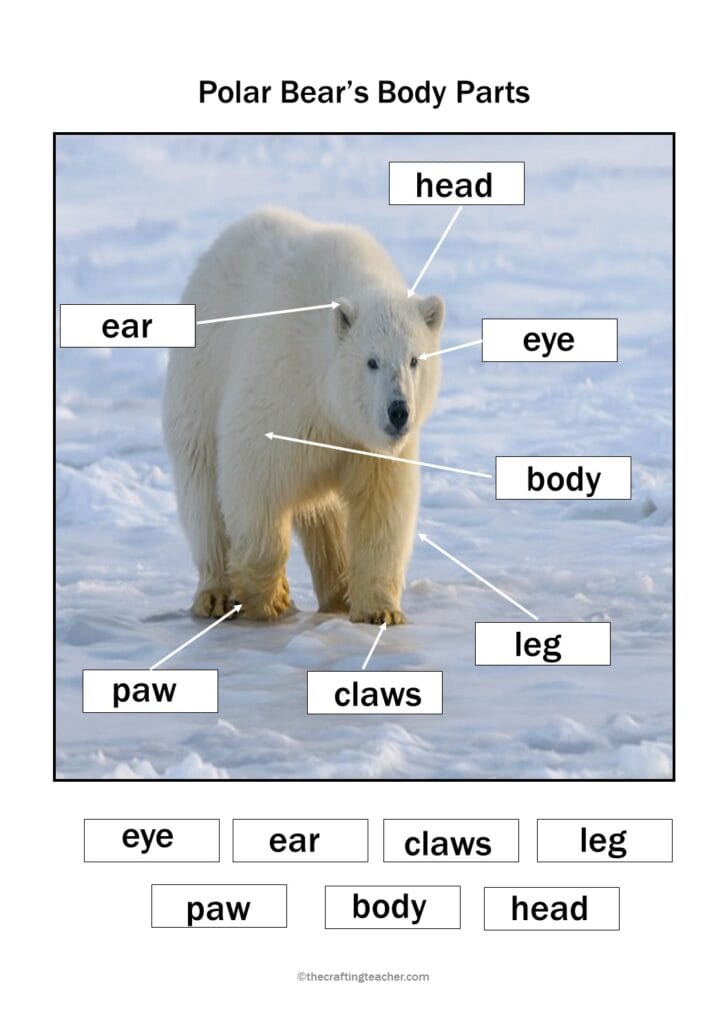
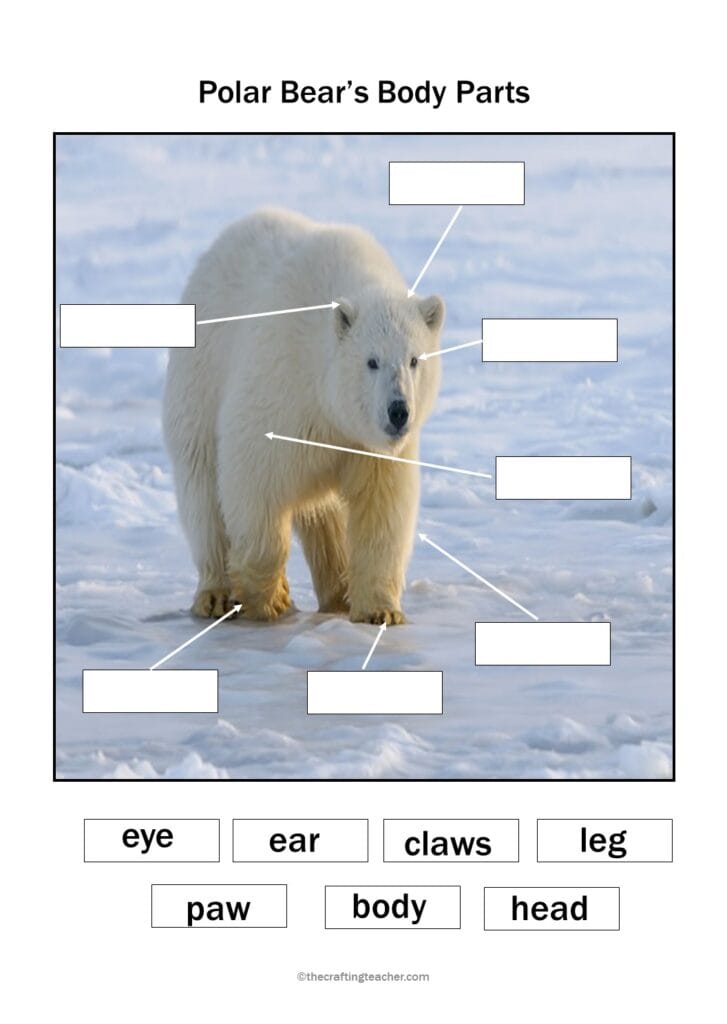
Children can practice matching the names of the body parts with the parts of the polar bear.
Name Match Activity
The story shows different animals, and this activity will encourage the children to match these animals’ names. The activity comes with five pages with two sets of cards each, for a total of twenty cards. Each set has one with the picture and name of each animal and another card with just the picture, plus labels. They include the ten different animals that appear in the story: polar bear, lion, hippopotamus, flamingo, zebra, boa constrictor, leopard, peacock, and walrus.
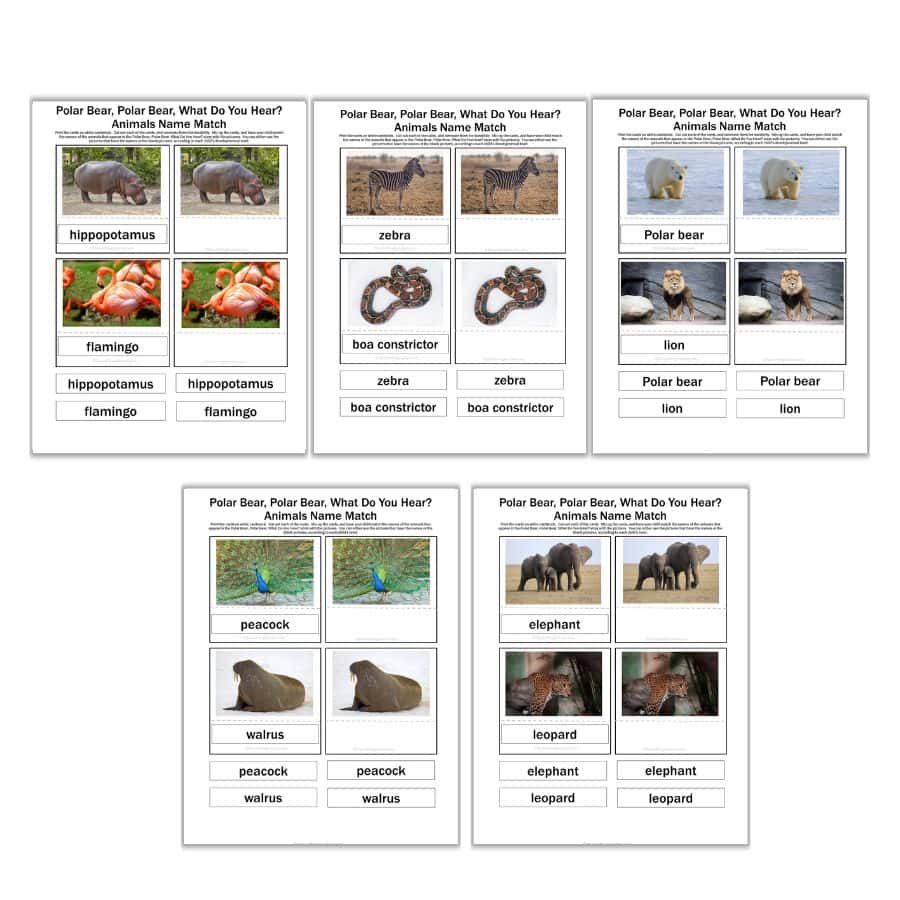
Print them in white cardstock and laminate them for durability. Cut out the tags with the names of the animals, and you can also put Velcro on the cards and the tags. You can find this FREE activity in the link below.
Other Ideas
- Habitats Sensory Bin – put water in your water table or a container. Include plastic water lilies, rocks, pebbles, and toy animals (the ones that appear in the story), and invite them to recreate the story.
- Float or Sink Experiment – use the same water table or container, and leave the materials outside. Invite the children to predict which items will float and which will sink. Provide a chart paper divided into two parts (float and sink). Invite them to take one item at a time and find out if their predictions are correct. Then have them write or draw the item in the appropriate column of the chart. After they finish, discuss their findings, and ask questions about their experiment such as: “Why do you think this item was going to float/sink?”; “What happened when you test it?”; “Why do you think that happens?”. This way you will encourage them to develop their scientific language and stimulate their scientific thinking, problem-solving, and reasoning skills.
- Cheese Tasting – bring cheese made with goat and cow milk. Have the children try them and select which is their favorite. Make a graph with their answers. Explain what type of milk was used for each of the cheeses. Use the opportunity to ask questions about the texture, flavor, color, etc.
- Wool Artwork – bring real wool to class and invite the children to use it to make art.
- Visit of an Expert – invite a zoo keeper, a zoologist, or a biologist to come to visit the classroom and talk to the children about the different animals.
- Fieldtrip – organize a trip to a close zoo with your preschoolers and their families. That way they can see some of these animals in person.
Other Polar Bear-related Books
You can always read and add more polar bear-related books to your library in other centers, to give children wide learning experiences and variety to choose from. These books could be an excellent source of knowledge. Below are some of my favorite books about polar bears. You can find these books at your local library, used book store, and on Amazon. The titles have my affiliate links, that will take you directly to the right Amazon page.
- All Things Polar Bears for Kids by Animal Reads. This colorful book, filled with captivating real-life photographs, combines fun with education to help young readers explore the world of polar bears.
- Polar Bear, Polar Bear, What Do You Hear? by Jill Martin Jr. and Eric Carle. This book uses the important pre-reading concepts of rhyme, rhythm, and repetition, to help children read by themselves.
- Are You a Polar Bear? by Andrew Gabriel. A polar bear cub wakes in his den to the snowy world outside after a long slumber. There’s no one around, not even his mom and he can’t remember what she looks like! The little cub journeys out to find her and along the way, he meets many arctic creatures that are not like him.
- National Geographic Readers: Polar Bears by Laura Marsh. This book will help children will learn about polar bears, using fascinating facts and beautiful images.
- If I Knew a Polar Bear by Karen Sutula. This is a beautifully illustrated 20-page book that is a fun poem about a polar bear and other arctic animals.
- Polar Bear Island by Lindsay Bonilla. This cute story of a bear that doesn’t want to share the island with penguins, delivers a gentle message of inclusivity.
- All About Polar Bears by EDventure Reading. This book teaches children about polar bears’ bodies, habitats, behaviors, and more through engaging text and beautiful full-color photography.
- Hush Little Polar Bear by Jeff Mack. Children follow the dream of a baby polar bear from the back of a whale to a land of tall grass, and happily right back to his bed.
- The Polar Bear’s Home by Lara Bergen. This storybook shows how global warming affects two baby polar bear cubs and their family, with tips for kids on what they can do to help slow down global warming.
You can use these ideas alone, but I invite you to combine them with the FREE Polar Bear, Polar Bear, and What Do You Hear? Literacy and Math packs I created for this story, to take advantage of the learning opportunities this book offers. Remember that for a comprehensive and complete educational process, you should not divorce literacy from math, science, or any other domain. They intermingle together and complement each other.
Pin It For Later
If you are in a rush and don’t have time to read the post and download the printable but want to save it for later, pin it to one of your Pinterest boards.

Don’t forget to download your FREE Polar Bear, Polar Bear, What Do You Hear? science pack. Just click the bottom below, and type your information, for an immediate download.
< wp:paragraph -->
Be happy, safe, and creative. I wish you well.
Love,

P.D. Please let me know if you like any of these ideas worked for you, or if you would like to see something else as well. My goal is to help you in any way I can.

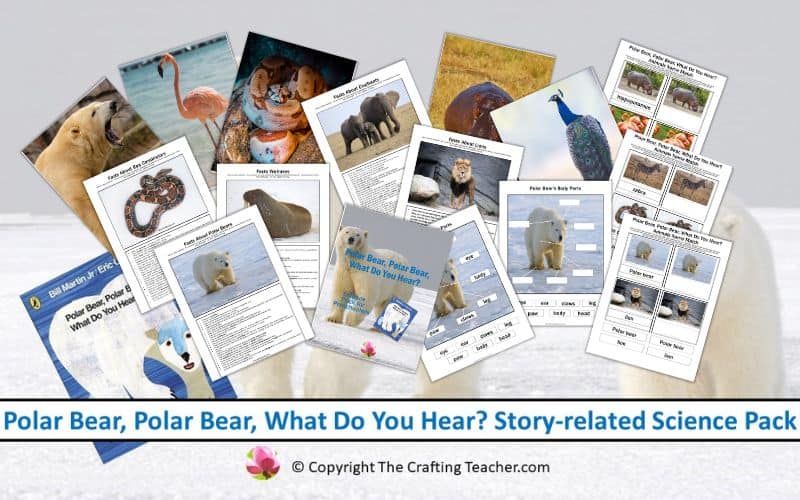
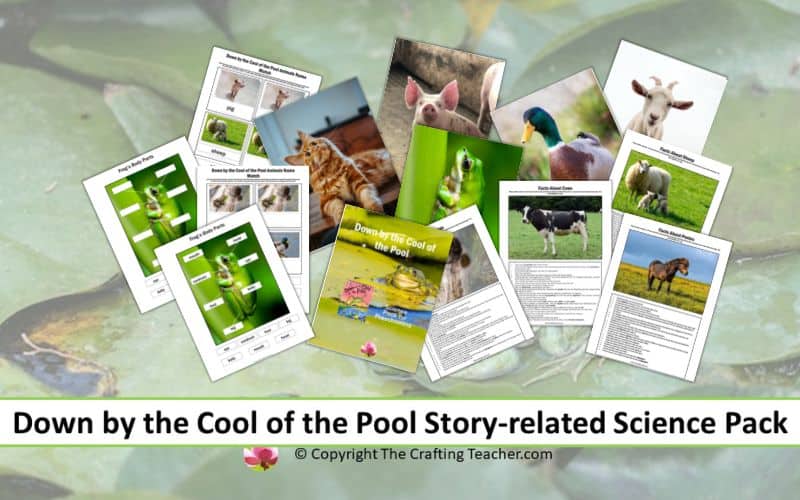




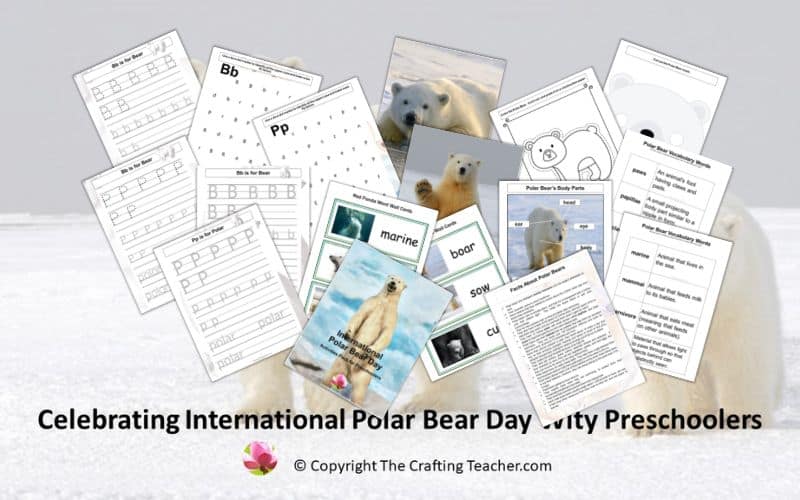
Looks very interesting!
Thank you. I appreciate your words. Let me know if I can help you with anything. Have a great day.